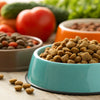Is Kibble or Fresh Food Better for Dogs? A Comprehensive Guide to Dog Nutrition
- Houndsy
Table of Contents
- Introduction
- The Evolution of Dog Food
- Understanding Kibble
- Exploring Fresh Dog Food
- Kibble vs. Fresh Food: Nutritional Breakdown
- Making the Right Choice for Your Dog
- Conclusion
Introduction
Have you ever looked at your dog's food bowl and wondered if you're truly providing the best nutrition possible? It's a question many dog owners grapple with, especially as the pet food landscape evolves. With a staggering 86% increase in the sales of fresh pet food since 2021, the debate between kibble and fresh food has never been more relevant. As devoted pet parents, we want to ensure our furry companions thrive, but with so many options available, how do we determine what’s best?
In this blog post, we will explore the pros and cons of kibble versus fresh food, diving deep into their nutritional benefits, convenience, cost, and overall impact on your dog's health. We aim to equip you with the knowledge to make an informed decision for your pet's dietary needs. By the end of this article, you will have a clearer understanding of whether kibble or fresh food is the better option for your dog, along with insights on how to elevate their feeding experience.
The Evolution of Dog Food
A Brief History
The pet food industry has come a long way since the first dog biscuits were invented in the late 1800s. Fast forward to the 1950s, when commercial kibble gained popularity, and we now have a wide array of options, including kibble, canned food, raw diets, and freshly prepared meals. Understanding this evolution helps us appreciate the variety of choices available today and the science behind them.
The Rise of Fresh Dog Food
Fresh dog food, often made with real, human-grade ingredients, is becoming increasingly popular among health-conscious pet owners. Brands like Houndsy are dedicated to providing quality products that enhance the daily feeding ritual, ensuring that mealtime is both nutritious and enjoyable for dogs. Our commitment to innovative design and functionality reflects in our flagship product, the Houndsy Kibble Dispenser, which simplifies the feeding process while maintaining a stylish appeal that complements modern home decor.
Understanding Kibble
What is Kibble?
Kibble, or dry dog food, consists of cooked and processed ingredients shaped into small, bite-sized pieces. It generally includes a combination of proteins, grains, and preservatives, all formulated to meet the nutritional needs of dogs.
Pros of Kibble
- Convenience: Kibble requires no refrigeration and has a long shelf life, making it easy for busy pet owners to store and serve. Simply scoop and serve!
- Cost-Effectiveness: Generally, kibble is more affordable than fresh food, making it a budget-friendly choice for many families.
- Balanced Nutrition: High-quality kibbles are formulated to provide a balanced diet, ensuring dogs receive essential nutrients in the right proportions.
- Dental Health: The crunchy texture of kibble can help reduce plaque and tartar buildup, promoting better dental health.
Cons of Kibble
- Moisture Content: Kibble typically lacks moisture, which can lead to dehydration, especially in dogs that do not drink enough water.
- Ingredient Quality: Not all kibbles are created equal. Some brands may use low-quality ingredients or fillers that do not provide adequate nutrition.
- Digestibility: Some dogs may have difficulty digesting kibble, especially if they have sensitive stomachs or specific dietary needs.
Exploring Fresh Dog Food
What is Fresh Dog Food?
Fresh dog food is made from whole, natural ingredients, often cooked gently to retain nutrients. These meals are typically labeled as "human-grade," indicating they meet the same safety standards as food meant for human consumption.
Pros of Fresh Dog Food
- Nutrient Density: Fresh food is often more nutrient-dense than kibble, containing fewer fillers and artificial preservatives, which can lead to better overall health for your dog.
- Palatability: Many dogs find fresh food more appealing due to its aroma and texture, which can help entice picky eaters.
- Digestibility: Fresh food is generally easier for dogs to digest, leading to smaller stools and improved nutrient absorption.
- Customization: Fresh dog food can be tailored to meet specific dietary needs, such as allergies or sensitivities, with many brands offering customized meal plans based on a dog's unique requirements.
Cons of Fresh Dog Food
- Cost: Fresh dog food can be significantly more expensive than kibble, which may not be feasible for all pet owners.
- Storage and Preparation: Fresh food requires careful storage and handling, including refrigeration or freezing. It also requires preparation time, which can be challenging for busy families.
- Shelf Life: Fresh food has a shorter shelf life compared to kibble, necessitating more frequent purchases and meal planning.
Kibble vs. Fresh Food: Nutritional Breakdown
To truly understand whether kibble or fresh food is better for your dog, let’s examine the nutritional aspects of both.
Nutritional Content
- Kibble: Typically contains a balance of protein, fats, carbohydrates, vitamins, and minerals. However, the quality of ingredients can vary widely. When selecting kibble, look for high-quality sources of protein as the first ingredient and avoid those with fillers like corn and soy.
- Fresh Food: Often contains real meat, vegetables, and grains, providing a closer approximation to a dog's natural diet. Fresh food is generally higher in moisture, which not only aids digestion but also keeps dogs hydrated.
A Closer Look at Ingredients
When considering what to feed your dog, it’s essential to read ingredient labels and understand what’s included:
- High-Quality Protein: Whether from kibble or fresh food, the primary source of protein should come from whole meats or meat meals.
- Fruits and Vegetables: Fresh dog food often includes a variety of fruits and vegetables, which provide essential vitamins and antioxidants.
- Grains vs. Grain-Free: Some dogs thrive on grain-inclusive diets, while others may benefit from grain-free options. It’s best to consult with a veterinarian to determine your dog's specific needs.
Making the Right Choice for Your Dog
Consider Your Dog's Unique Needs
Every dog is different, and their dietary needs can vary based on several factors, including:
- Age: Puppies, adults, and senior dogs have different nutritional requirements.
- Size: Larger breeds may have different caloric needs than smaller breeds.
- Health Conditions: Dogs with specific health issues may benefit from tailored diets.
Consult with a Veterinarian
Before making any significant changes to your dog's diet, it’s crucial to consult with a veterinarian. They can provide personalized recommendations based on your dog's health history, lifestyle, and nutritional requirements.
Balancing Kibble and Fresh Food
For those looking to strike a balance between the two, consider mixing high-quality kibble with fresh food. This approach allows you to maintain the convenience of kibble while enhancing your dog’s diet with the nutritional benefits of fresh ingredients.
Conclusion
The choice between kibble and fresh food ultimately depends on your dog’s individual needs, your lifestyle, and your budget. While both options have their merits, it’s essential to prioritize quality and nutrition when selecting a diet for your furry friend.
At Houndsy, we understand the importance of a seamless and enjoyable feeding experience. Our Houndsy Kibble Dispenser is designed to enhance the daily feeding ritual—delivering perfectly portioned meals while keeping your home looking stylish.
Ready to elevate your dog's feeding experience? Explore our Houndsy Kibble Dispenser today and discover how we can simplify mealtime for you and your beloved pet.
FAQ
1. Can I mix kibble and fresh food?
Yes, many pet owners choose to mix high-quality kibble with fresh food to provide a balanced diet that combines the benefits of both.
2. What should I look for when choosing kibble?
Look for kibble that lists a high-quality source of protein as the first ingredient, avoids fillers like corn and soy, and meets AAFCO nutritional standards.
3. Is fresh food always better than kibble?
Not necessarily. While fresh food often contains high-quality ingredients and fewer preservatives, kibble can also be a nutritious option if made with quality ingredients. It ultimately depends on your dog’s individual needs and preferences.
4. How can I transition my dog to a new diet?
When transitioning to a new food, do so gradually over a week or more, mixing the new food with the old to prevent digestive upset. Monitor your dog's response to the new food during this period.
5. Should I consult my veterinarian before changing my dog's diet?
Yes, it’s always best to consult with your veterinarian to ensure that any dietary changes meet your dog’s specific health and nutritional needs.













